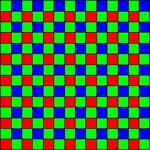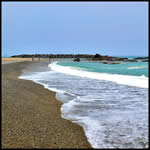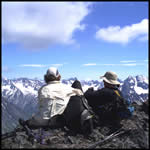Gary's Parries 23/07/06
 This week’s Gary’s Parries topics are:
This week’s Gary’s Parries topics are:
1. Different Horizontal And Vertical Resolutions
2. Digital Dust Revisited
3. Olympus Stylus 710, A Good Choice
Introducing this week’s Gary’s Parries column. Everything you always wanted to know about digital cameras, but were afraid to ask. No question too difficult, or too easy. As a Senior Principal Software Engineer, and a former Assistant Professor of Computer Information Systems, as well as a recording studio owner/operator, inventor, and now, a digital camera enthusiast, GARY has more digital camera knowledge in his entire brain than most people have in their little finger. In the unlikely event that GARY would not know the answer to your question, he will answer it anyway, true to the spirit of the word “Parries”, a fencing term which, in this context, implies “cleverly evasive answers”. So let your imagination run wild. Email all your nagging digital camera questions to: [email protected] , and then, En Garde!
You may also attach to your email an ORIGINAL PHOTO of your choosing. A preview of the photo will be displayed with your question, and a full-sized version will be just a click away. No personal information will be published with your question unless you specifically include it in the text or attached photo of your email, which may be further edited for grammar, content, or other reasons.
***
*** QUESTION 1—- DIFFERENT HORIZONTAL AND VERTICAL RESOLUTIONS
***
 Gary,
Gary,
I wonder why many cameras have a different resolution vertically vs. horizontally? It was my understanding that the standard test chart has been adjusted to compensate for differences in the number of vertical vs. horizontal pixels.
Regards,
Anders Tiberg
***
*** ANSWER 1
***
This is a good question, Anders. Thinking aloud, what does cause different horizontal and vertical LPH (Lines per Picture Height) measurements for the same camera? I can tell you what it isn’t. It is NOT the image sensor’s aspect ratio since, as you suggested, LPH measurements are normalized to remove any dependence on physical measurements and proportions. Also, the phenomenon has occurred often enough that we can certainly rule out human error.
There are many factors that can affect the directional resolving capabilities of a digital camera, not just horizontally and vertically, but diagonally, as well. The diagonal is easy to understand. If a camera with square pixels has an equal number of pixels per unit length in both the horizontal and vertical directions, it will have 1.4x less pixels per unit length along the diagonal (i.e., the same number of pixels will cover 1.4x the length, as calculated using the Pythagorean ratio of the hypotenuse length to the side length in an equilateral right triangle).
Most cameras actually do have square pixels equally spaced in all directions (notable exceptions being the Nikon D1X and cameras using a Fujifilm SuperCCD or Foveon X3 CCD), so you would expect their horizontal and vertical resolutions to be equal. But, as you pointed out, that is often not the case, and understandably so, as there are many other physical factors besides pixel density that can affect resolution, including the position within an image, the image brightness and contrast, the focal length and aperture of the lens, the camera’s ISO setting, and the camera’s anti-aliasing filter and color filter array.
The thing of it is though, all of these factors, while significantly impacting resolution, would do so in a uniform manner, and could not introduce the observed directionality of resolution. Did I mention that this is a very good question, Anders?
The are also a number of internal firmware processing algorithms that can affect a camera’s resolution, including its sharpness control, its color intensity interpolation (in conjunction with the color filter array), its image size interpolation and compression, and its JPEG compression. However, except for fact that JPEG compression algorithms have a directional nature whereby horizontal and vertical patterns are compressed differently, I would not expect any of these factors to influence resolution in a directional manner. Did I mention, Anders, that this is an excellent question?
So what about JPEG compression? Is it single-handedly accounting for the measured differences in a camera’s horizontal vs. vertical resolution? Well, here’s the thing. Even when resolution tests are performed using the camera’s uncompressed TIFF or RAW mode, comparable resolution differences occur. You know, Anders, this may have been the best Gary’s Parries question, to date. :)
***
*** QUESTION 2—- DIGITAL DUST REVISITED
***
I have been a semi-pro Nikon user for some time, and have heard about the digital dust problem. With my film cameras, I sometimes change lenses in a dark changing bag with two openings for hands when I’m on the beach or in dusty environments, and/or when loading infrared film. I have also seen a clear changing bag. Would that help to lessen dirt on the DSLR sensor while changing lenses? I am thinking of purchasing my first DSLR, the Nikon D200.
Regards,
Terry Stick
Florida
***
*** ANSWER 2
***
Yes, Terry, a clear changing bag will definitely help to postpone the inevitable, namely, having your sensor cleaned by an authorized service representative. It’s really not that terrible if you have film cameras to use while your digital is being serviced. :)
With a D200, you will be able to use Nikon’s Capture software to automatically remove dust in post-processing, but only if you shoot in RAW mode. Good luck with the D200, and please let us know how the dust situation works out.
[Note: For a complete discussion of digital dust, see last week’s Gary’s Parries. Thanks to Nick in Japan for submitting the accompanying photo. This one also seems to have the previously mentioned (magenta) blotch pattern in the sky. – Ed.]
***
*** QUESTION 3—- OLYMPUS STYLUS 710, A GOOD CHOICE
***
A while back, based on the extreme environments in which I was intending to use my camera, you advised me to purchase the weatherproof Olympus Stylus 710, rather than the FE-140 I was intending to buy for its AA battery compatibility. I just got back from Alaska (my first trip with the 710) and wanted to give you some feedback as to how the camera performed.
Its small size was very convenient - more so than I had previously imagined. The picture quality was average, but as long as it is not poor, it will be acceptable to me. The limiting factor on picture quality for all my photos will be me, not the camera. :)
Olympus did a reasonably good job of making the camera’s controls easy to understand and use. The only documentation I have read thus far is the Quick Start Guide. I have not read the Users Manual or the Advanced Users Manual. Since I was not very demanding of the camera, this was okay. There were a few issues that I could not figure out, but I got by.
Over the course of my 2 weeks vacation, I shot about 60 photos, and I did not deplete even the first of my two batteries. So battery life is going to be fine. The proprietary batteries are okay; however, I still would have preferred using AAA Lithium batteries in combination with the AAA to AA converters you found for me. But that obviously would have increased the camera’s size and weight a bit - the proprietary battery is very compact.
All in all, the Olympus Stylus 710 was a good choice. Thank you for steering me in that direction.
(A note on camera philosophy: For the first few trips I took to distant locations, I did not take any camera at all. I think that says a lot about my stance on cameras. Frequently I buy post cards of places I visit. A talented person has already captured the image, so what value would it be for me to make yet another, lower quality image? I have read recommendations from some others suggesting not to take cameras on such trips. Their reasoning is that the purpose of the trip is to be ‘in’ the moment, not thinking about how you can capture and ‘relive’ the moment later.)
***
*** ANSWER 3
***
Glad to hear the 710 worked out well. My biggest concern was with its mediocre image quality, but your environmental considerations made its recommendation a no brainer.
Regarding your camera philosophy, I can relate to that, and have even taken it a step further. Whenever my wife sees an exotic vacation spot on television, and then tries to get me interested, I always tell her, what’s the point, we’ve already seen it on TV. :)
P.S. Great shot of a great view, summertime in Alaska, and the Olympus captured it beautifully !!!
***
[Column photo “The Photographer” by Brenda LaFleur of Brenda LaFleur Photography.]


